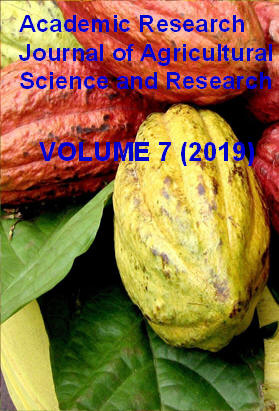|
ISSN: 2360-7874 |
Academic Research Journal of
Agricultural Science and Research |
|||||||||||||||||||
|
Vol. 7(7), pp. 385-395, November 2019 Research Evaluating Yield and Yield Related Performance of Drought and Striga Tolerant Sorghum Genotypes in Northwestern Tigray
Hailegebrial K.,Yirgalem T., Weledegerima G., Redae W., Alem R., & Eyasu A.
Plant Breeder, Shire-Maitsebri Agricultural Research Center. E-mail: hailatkinfe@gmail.com
Accepted 28 August 2019
Sorghum (Sorghum bicolor L) is the fourth most important cereal crop worldwide and occupies the second position among the staple food grains in semi-arid tropics. The adaptation of grain sorghum to a wide range of environmental conditions has led to the evolution and existence of extensive genetic variation for drought and striga tolerance. The crop requires relatively less water than other important cereals such as maize and wheat. However, yield potential of the crop is significantly limited due to major constraints of drought and striga infestations and those affect sorghum production worldwide and continue to be a challenge to plant breeders, despite many decades of research. Drought impairs normal growth, disturbs water relations, reduces water use efficiency and affects yield. Underestimating the different mechanisms underlying drought tolerance is vital for the breeding to alleviate adverse effects of drought in order to boost productivity. A field experiment with twenty nine striga and drought tolerant genotypes by three replications using randomized complete block design was conducted at Tahtay adiabo and Tselemti districts to evaluate the drought and striga tolerance traits in addition to performance of yield and major yield related traits. Tolerant genotypes can therefore be used to improve yield and crop performance hence alleviating food insecurity, poverty and famine among smallholder farmers. Hence, finally with considering the overall phenotypic performance (acceptability), stay greenness trait (1-5 scale scoring), striga infestation (with relating tolerant traits) genotype 38 with mean grain yield of 40.8 qt/ha and genotype 9(33. 8 qt/ha) were selected and promoted to variety verification trial with including highly striga infested and drought prone testing sites using recently released comparable standard checks.
How to cite this article (APA Style): Hailegebrial K.,Yirgalem T., Weledegerima G., Redae W., Alem R., & Eyasu A. (2019). Evaluating Yield and Yield Related Performance of Drought and Striga Tolerant Sorghum Genotypes in Northwestern Tigray. Acad. Res. J. Agri. Sci. Res. 7(7): 385-395
|
|||||||||||||||||||
